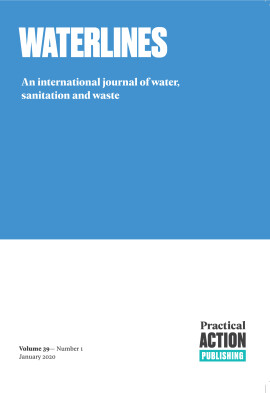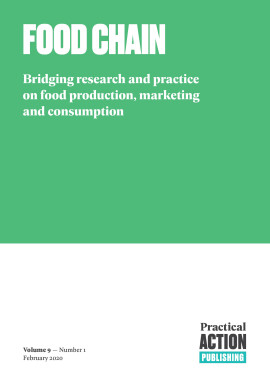Loan demand in Jordanian microfinance market: interest rate elasticity and loan-acceptance prediction via logistic regression
Currently, more and more competitors enter the Jordanian microfinance market, offering a greater range of differentiated loan products, aggressive interest rates and loan terms. Our goal is to formulate loan-acceptance prediction methods and, ultimately, pricing strategies for Jordanian microfinance products by studying the customer behaviour of one of the three largest microfinance institutions in Jordan with a particular focus on interest elasticity of demand. We examine the hypothesis of a low interest rate elasticity of demand, and the possibility of increasing the interest rate without cannibalizing loan demand. We plan a methodology to pin down average interest rate elasticity by determining the driving factors affecting the demand. The methodologies we use are based on empirical demand studies and a logistic regression dependence model for loan demand. As a by-product of these studies, we provide a data set including 63 different demographic, educational, household, loan, and other characteristics for more than 900 randomly selected clients across Jordan.Bell, C., Srinivasan, T.N. and Udry, C. (1997) ‘Rationing, spillover, and interlinking in credit markets: the case of rural Punjab’, Oxford Economic Papers 49(4): 557–85.
Central Intelligence Agency (2014) The World Factbook [online] <https://www.cia.gov/library/publications/resources/the-world-factbook/index.html> [accessed 3 September 2015].
Dehejia, R., Montgomery, H. and Morduch, J. (2011) ‘Do interest rates matter? Credit demand in the Dhaka slums’, Journal of Development Economics 97(2): 437–49 <http://dx.doi.org/10.1016/j.jdeveco.2011.06.001>.
El-Zoghbi, M., Karlan, D., Osman, A. and Shammout, N. (2016) Understanding Demand for Sharia-compliant Loans: Results of a Randomized Experiment in Jordan [pdf], CGAP brief, Washington, DC: World Bank Group <http://documents.worldbank.org/curated/en/856701468196732651/Understanding-demand-for-Sharia-compliant-loans-results-of-a-randomized-experiment-in-Jordan> [accessed 25 December 2016].
Karlan, D.S. and Zinman, J. (2006) ‘Expanding Credit Access: Using Randomized Supply Decisions to Estimate the Impacts’, <http://www.dartmouth.edu/~jzinman/Papers/Derationing.Karlan-Zinman.pdf>
Karlan, D.S. and Zinman, J. (2008) ‘Credit elasticities in less-developed economies: implications for microfinance’, American Economic Review 98(3): 1040–68 <http://dx.doi.org/10.1257/aer.98.3.1040>.
Karlan, D.S. and Zinman, J. (2014) Long-Run Price Elasticities of Demand for Credit: Evidence from a Countrywide Field Experiment in Mexico [pdf], Innovations for Poverty Action, MIT Jameel Poverty Action Lab <http://karlan.yale.edu/sites/default/files/longruncreditelasts_v110.pdf> [accessed 25 December 2016].
Kocchar, A. (1997) ‘An empirical investigation of rationing constraints in rural credit markets in India’, Journal of Development Economics 53(2): 339–71.
Ministry of Planning and International Cooperation (2012) Jordan Microfinance Market Study [pdf] <www.mop.gov.jo/echobusv3.0/SystemAssets/24092014/Jordan%20Microfinance%20Market%20Study%202012.pdf> [accessed 3 September 2015].
Porteous, D. (2006) Competition and Microcredit Interest Rates [pdf], CGAP Focus Note No. 33 <https://www.cgap.org/sites/default/files/CGAP-Focus-Note-Competition-and-Microcredit-Interest-Rates-Feb-2006.pdf> [accessed 9 September 2017].
Portocarrero Maisch, F., Soria, A.T. and Westley, G.D. (2006) How Should Microfinance Institutions Best Fund Themselves? [pdf], Inter-American Development Bank Sustainable Development Department Best Practices Series (November) <www.rrojasdatabank.info/iadbremit/howshould.pdf> [accessed 9 September 2017].
Rosenberg, R., Gaul, S., Ford, W. and Tomilova, O. (2013) Microcredit Interest Rates and Their Determinants: 2004–2011, Access to Finance Forum, Reports by CGAP and Its Partners, No. 7 (June), Washington, DC: CGAP.
Salazar, G., Bogan, V. and Turvey, C. (2010) ‘The elasticity of demand for microcredit’, Development Policy Review 33(6): 725–57 <http://dx.doi.org/10.1111/dpr.12131>.
UNESCO (2012) Education for All Global Monitoring Report: Education in Jordan [pdf], Paris: UNESCO <http://en.unesco.org/gem-report/sites/gem-report/files/Jordan_fact_sheet.pdf> [accessed 25 December 2016].
UNESCO (2015) Education: Adult literacy rate [online database] <http://data.unicef.org/topic/education/literacy/> [accessed 26 December 2016].
Whittaker, M. (2008) ‘South Africa’s National Credit Act: a possible model for the proper role of interest rate ceilings for microfinance’, Northwestern Journal of International Law and Business 28(3): 561–81.
Bell, C., Srinivasan, T.N. and Udry, C. (1997) ‘Rationing, spillover, and interlinking in credit markets: the case of rural Punjab’, Oxford Economic Papers 49(4): 557–85.
Central Intelligence Agency (2014) The World Factbook [online] <https://www.cia.gov/library/publications/resources/the-world-factbook/index.html> [accessed 3 September 2015].
Dehejia, R., Montgomery, H. and Morduch, J. (2011) ‘Do interest rates matter? Credit demand in the Dhaka slums’, Journal of Development Economics 97(2): 437–49 <http://dx.doi.org/10.1016/j.jdeveco.2011.06.001>.
El-Zoghbi, M., Karlan, D., Osman, A. and Shammout, N. (2016) Understanding Demand for Sharia-compliant Loans: Results of a Randomized Experiment in Jordan [pdf], CGAP brief, Washington, DC: World Bank Group <http://documents.worldbank.org/curated/en/856701468196732651/Understanding-demand-for-Sharia-compliant-loans-results-of-a-randomized-experiment-in-Jordan> [accessed 25 December 2016].
Karlan, D.S. and Zinman, J. (2006) ‘Expanding Credit Access: Using Randomized Supply Decisions to Estimate the Impacts’, <http://www.dartmouth.edu/~jzinman/Papers/Derationing.Karlan-Zinman.pdf>
Karlan, D.S. and Zinman, J. (2008) ‘Credit elasticities in less-developed economies: implications for microfinance’, American Economic Review 98(3): 1040–68 <http://dx.doi.org/10.1257/aer.98.3.1040>.
Karlan, D.S. and Zinman, J. (2014) Long-Run Price Elasticities of Demand for Credit: Evidence from a Countrywide Field Experiment in Mexico [pdf], Innovations for Poverty Action, MIT Jameel Poverty Action Lab <http://karlan.yale.edu/sites/default/files/longruncreditelasts_v110.pdf> [accessed 25 December 2016].
Kocchar, A. (1997) ‘An empirical investigation of rationing constraints in rural credit markets in India’, Journal of Development Economics 53(2): 339–71.
Ministry of Planning and International Cooperation (2012) Jordan Microfinance Market Study [pdf] <www.mop.gov.jo/echobusv3.0/SystemAssets/24092014/Jordan%20Microfinance%20Market%20Study%202012.pdf> [accessed 3 September 2015].
Porteous, D. (2006) Competition and Microcredit Interest Rates [pdf], CGAP Focus Note No. 33 <https://www.cgap.org/sites/default/files/CGAP-Focus-Note-Competition-and-Microcredit-Interest-Rates-Feb-2006.pdf> [accessed 9 September 2017].
Portocarrero Maisch, F., Soria, A.T. and Westley, G.D. (2006) How Should Microfinance Institutions Best Fund Themselves? [pdf], Inter-American Development Bank Sustainable Development Department Best Practices Series (November) <www.rrojasdatabank.info/iadbremit/howshould.pdf> [accessed 9 September 2017].
Rosenberg, R., Gaul, S., Ford, W. and Tomilova, O. (2013) Microcredit Interest Rates and Their Determinants: 2004–2011, Access to Finance Forum, Reports by CGAP and Its Partners, No. 7 (June), Washington, DC: CGAP.
Salazar, G., Bogan, V. and Turvey, C. (2010) ‘The elasticity of demand for microcredit’, Development Policy Review 33(6): 725–57 <http://dx.doi.org/10.1111/dpr.12131>.
UNESCO (2012) Education for All Global Monitoring Report: Education in Jordan [pdf], Paris: UNESCO <http://en.unesco.org/gem-report/sites/gem-report/files/Jordan_fact_sheet.pdf> [accessed 25 December 2016].
UNESCO (2015) Education: Adult literacy rate [online database] <http://data.unicef.org/topic/education/literacy/> [accessed 26 December 2016].
Whittaker, M. (2008) ‘South Africa’s National Credit Act: a possible model for the proper role of interest rate ceilings for microfinance’, Northwestern Journal of International Law and Business 28(3): 561–81.
Bell, C., Srinivasan, T.N. and Udry, C. (1997) ‘Rationing, spillover, and interlinking in credit markets: the case of rural Punjab’, Oxford Economic Papers 49(4): 557–85.
Central Intelligence Agency (2014) The World Factbook [online] <https://www.cia.gov/library/publications/resources/the-world-factbook/index.html> [accessed 3 September 2015].
Dehejia, R., Montgomery, H. and Morduch, J. (2011) ‘Do interest rates matter? Credit demand in the Dhaka slums’, Journal of Development Economics 97(2): 437–49 <http://dx.doi.org/10.1016/j.jdeveco.2011.06.001>.
El-Zoghbi, M., Karlan, D., Osman, A. and Shammout, N. (2016) Understanding Demand for Sharia-compliant Loans: Results of a Randomized Experiment in Jordan [pdf], CGAP brief, Washington, DC: World Bank Group <http://documents.worldbank.org/curated/en/856701468196732651/Understanding-demand-for-Sharia-compliant-loans-results-of-a-randomized-experiment-in-Jordan> [accessed 25 December 2016].
Karlan, D.S. and Zinman, J. (2006) ‘Expanding Credit Access: Using Randomized Supply Decisions to Estimate the Impacts’, <http://www.dartmouth.edu/~jzinman/Papers/Derationing.Karlan-Zinman.pdf>
Karlan, D.S. and Zinman, J. (2008) ‘Credit elasticities in less-developed economies: implications for microfinance’, American Economic Review 98(3): 1040–68 <http://dx.doi.org/10.1257/aer.98.3.1040>.
Karlan, D.S. and Zinman, J. (2014) Long-Run Price Elasticities of Demand for Credit: Evidence from a Countrywide Field Experiment in Mexico [pdf], Innovations for Poverty Action, MIT Jameel Poverty Action Lab <http://karlan.yale.edu/sites/default/files/longruncreditelasts_v110.pdf> [accessed 25 December 2016].
Kocchar, A. (1997) ‘An empirical investigation of rationing constraints in rural credit markets in India’, Journal of Development Economics 53(2): 339–71.
Ministry of Planning and International Cooperation (2012) Jordan Microfinance Market Study [pdf] <www.mop.gov.jo/echobusv3.0/SystemAssets/24092014/Jordan%20Microfinance%20Market%20Study%202012.pdf> [accessed 3 September 2015].
Porteous, D. (2006) Competition and Microcredit Interest Rates [pdf], CGAP Focus Note No. 33 <https://www.cgap.org/sites/default/files/CGAP-Focus-Note-Competition-and-Microcredit-Interest-Rates-Feb-2006.pdf> [accessed 9 September 2017].
Portocarrero Maisch, F., Soria, A.T. and Westley, G.D. (2006) How Should Microfinance Institutions Best Fund Themselves? [pdf], Inter-American Development Bank Sustainable Development Department Best Practices Series (November) <www.rrojasdatabank.info/iadbremit/howshould.pdf> [accessed 9 September 2017].
Rosenberg, R., Gaul, S., Ford, W. and Tomilova, O. (2013) Microcredit Interest Rates and Their Determinants: 2004–2011, Access to Finance Forum, Reports by CGAP and Its Partners, No. 7 (June), Washington, DC: CGAP.
Salazar, G., Bogan, V. and Turvey, C. (2010) ‘The elasticity of demand for microcredit’, Development Policy Review 33(6): 725–57 <http://dx.doi.org/10.1111/dpr.12131>.
UNESCO (2012) Education for All Global Monitoring Report: Education in Jordan [pdf], Paris: UNESCO <http://en.unesco.org/gem-report/sites/gem-report/files/Jordan_fact_sheet.pdf> [accessed 25 December 2016].
UNESCO (2015) Education: Adult literacy rate [online database] <http://data.unicef.org/topic/education/literacy/> [accessed 26 December 2016].
Whittaker, M. (2008) ‘South Africa’s National Credit Act: a possible model for the proper role of interest rate ceilings for microfinance’, Northwestern Journal of International Law and Business 28(3): 561–81.
Bell, C., Srinivasan, T.N. and Udry, C. (1997) ‘Rationing, spillover, and interlinking in credit markets: the case of rural Punjab’, Oxford Economic Papers 49(4): 557–85.
Central Intelligence Agency (2014) The World Factbook [online] <https://www.cia.gov/library/publications/resources/the-world-factbook/index.html> [accessed 3 September 2015].
Dehejia, R., Montgomery, H. and Morduch, J. (2011) ‘Do interest rates matter? Credit demand in the Dhaka slums’, Journal of Development Economics 97(2): 437–49 <http://dx.doi.org/10.1016/j.jdeveco.2011.06.001>.
El-Zoghbi, M., Karlan, D., Osman, A. and Shammout, N. (2016) Understanding Demand for Sharia-compliant Loans: Results of a Randomized Experiment in Jordan [pdf], CGAP brief, Washington, DC: World Bank Group <http://documents.worldbank.org/curated/en/856701468196732651/Understanding-demand-for-Sharia-compliant-loans-results-of-a-randomized-experiment-in-Jordan> [accessed 25 December 2016].
Karlan, D.S. and Zinman, J. (2006) ‘Expanding Credit Access: Using Randomized Supply Decisions to Estimate the Impacts’, <http://www.dartmouth.edu/~jzinman/Papers/Derationing.Karlan-Zinman.pdf>
Karlan, D.S. and Zinman, J. (2008) ‘Credit elasticities in less-developed economies: implications for microfinance’, American Economic Review 98(3): 1040–68 <http://dx.doi.org/10.1257/aer.98.3.1040>.
Karlan, D.S. and Zinman, J. (2014) Long-Run Price Elasticities of Demand for Credit: Evidence from a Countrywide Field Experiment in Mexico [pdf], Innovations for Poverty Action, MIT Jameel Poverty Action Lab <http://karlan.yale.edu/sites/default/files/longruncreditelasts_v110.pdf> [accessed 25 December 2016].
Kocchar, A. (1997) ‘An empirical investigation of rationing constraints in rural credit markets in India’, Journal of Development Economics 53(2): 339–71.
Ministry of Planning and International Cooperation (2012) Jordan Microfinance Market Study [pdf] <www.mop.gov.jo/echobusv3.0/SystemAssets/24092014/Jordan%20Microfinance%20Market%20Study%202012.pdf> [accessed 3 September 2015].
Porteous, D. (2006) Competition and Microcredit Interest Rates [pdf], CGAP Focus Note No. 33 <https://www.cgap.org/sites/default/files/CGAP-Focus-Note-Competition-and-Microcredit-Interest-Rates-Feb-2006.pdf> [accessed 9 September 2017].
Portocarrero Maisch, F., Soria, A.T. and Westley, G.D. (2006) How Should Microfinance Institutions Best Fund Themselves? [pdf], Inter-American Development Bank Sustainable Development Department Best Practices Series (November) <www.rrojasdatabank.info/iadbremit/howshould.pdf> [accessed 9 September 2017].
Rosenberg, R., Gaul, S., Ford, W. and Tomilova, O. (2013) Microcredit Interest Rates and Their Determinants: 2004–2011, Access to Finance Forum, Reports by CGAP and Its Partners, No. 7 (June), Washington, DC: CGAP.
Salazar, G., Bogan, V. and Turvey, C. (2010) ‘The elasticity of demand for microcredit’, Development Policy Review 33(6): 725–57 <http://dx.doi.org/10.1111/dpr.12131>.
UNESCO (2012) Education for All Global Monitoring Report: Education in Jordan [pdf], Paris: UNESCO <http://en.unesco.org/gem-report/sites/gem-report/files/Jordan_fact_sheet.pdf> [accessed 25 December 2016].
UNESCO (2015) Education: Adult literacy rate [online database] <http://data.unicef.org/topic/education/literacy/> [accessed 26 December 2016].
Whittaker, M. (2008) ‘South Africa’s National Credit Act: a possible model for the proper role of interest rate ceilings for microfinance’, Northwestern Journal of International Law and Business 28(3): 561–81.
Intelligent Computing and Optimization
A Significant Estimation and Prediction of High and Low Risk in Approving Bank Loan by Using Novel Creditworthiness by Comparing Support Vector Machine Model Over Logistic Regression
Kandia, V. S. Prasad
Lakshmib, Pedisetti Prasanna
Ravipatic, Venkata Sai Malavika
Kumar, Bendadi. Mohith
Ramachandran, M.
2024
https://doi.org/10.1007/978-3-031-73324-6_62 [Citations: 0]- Value chain financing: evidence from Zambia on smallholder access to finance for mechanization
- Boosting financial inclusion through social assistance reform: evidence-based approach in selecting a payment system
- Developing agro-pastoral entrepreneurship: bundling blended finance and technology
- Building frontline market facilitators' capacity: the case of the ‘Integrating Very Poor Producers into Value Chains Field Guide’
- Impact of COVID-19 on livestock exports from Somalia and the Horn of Africa


